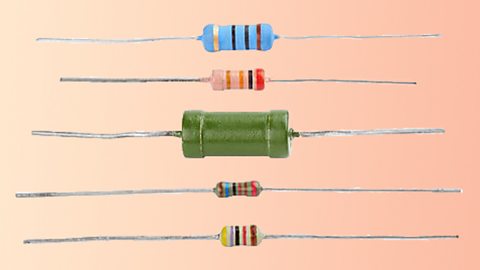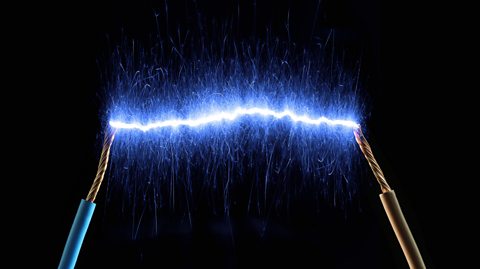Key points
Models can be used to help us understand electrical circuits.
Each model has its advantages and limitations.
Video - Introduction to circuits
For electricity to flow, everything needs to be connected in a big ring. It’s called a circuit.
For example, the lights in most houses and flats are part of a circuit controlled by the consumer unit, where power enters the house.
We can see how circuits work, and represent them with some simple diagrams, using basic electrical components like these.
You start with a cell, or combination of cells. These could be batteries, solar panels, or a power supply connected to the mains - anything that can provide power to our circuit.
A wire from the cell can then be connected to a component like a bulb.
And to complete the circuit you need to connect it back to the other side of the cell.
Ah! There we go!
You can put all kinds of other components in the circuit, to be powered by the cell.
Like a motor.
Or you can even put in a switch that can temporarily break the circuit.
We can also add in some components that measure the current and the potential difference.
An ammeter tells you the current, or the flow of charge through the circuit, measured in amps. In this circuit it’s nought point two three amps.
And a voltmeter measures the potential difference in volts, which is the difference in energy between two parts of a circuit. Across the cell here, we can see it is one point four one volts.
Because the flow of electricity is invisible, it can be pretty tricky to imagine what’s going on inside all the tiny wires. So it helps to think of an electrical circuit a bit like the central heating system in a house. We call this comparison a model.
The cell or battery is like the boiler and the pump, pushing hot water around. The current flowing through the wires is like hot water going through the pipes.
And the radiators are where we can feel the results of that circulating hot water, just like we see the results of the electricity flowing through the bulb.
And, of course, the central heating system has to be connected back to the boiler, or else you’d have water everywhere.Don’t worry though, if an electrical circuit isn’t connected back to the cell, it just doesn’t work. You don’t get electricity spilling out of the wires!
So the next time you switch on a light, you can imagine the flow of electricity, like hot water, looping around a huge circuit.
Can you answer these questions based on the video?
In an electrical circuit, what are bulbs, switches and motors collectively known as?
Why does it help to think of an electrical circuit a bit like the central heating system in a house?
They are known as components and each one is represented by its own symbol when drawing an electrical circuit diagram.
The flow of electricity is invisible and it can be difficult to understand what’s going on inside all the wires. A model, such as a central heating system in a house, can make it easier to understand a circuit.
The water model
An example of the water model of electricity is a central heating system:
the pump acts like the cell or battery
the pipes are like the wires
the radiator is like a component, for example a lamp, transferring energy to the room
the water flow is like the electrical current
In many ways, electrical current behaves like water flowing through a closed ring of piping. The movement of the water through the pipe is like the movement of electrons through a circuit.
The diagram shows a central heating system.
This circuit diagram represents the water model.
The pump acts like a cell or battery. When the pump is switched on, it produces a pressure difference across the pump. This pressure difference causes water to flow around the loop – just like the potential difference produced by a cell or battery causes electrical current to flow in a circuit.
The amount of water flowing past any point in the loop each second is the same. There are no leaks in the pipe.
The amount of current flowing in a series circuit (a circuit with only one loop) is also the same in all parts of the circuit. Find out more about series circuits.
The radiator creates resistance to the flow of water, like a component (eg a lamp).
The flow meter measuring the rate of flow of water is like an ammeter which measures the rate of flow of electrical charge.
The valve acts like a switch.
Limitations of the water model
If a pipe breaks then water leaks out. If a wire breaks the electrical current does not leak out, instead it stops flowing altogether.
Wires always contain electrons, even if they are not connected into a circuit, but a water pipe could be empty.
The rope model
The rope model is a useful tool to help us understand ł¦łÜ°ů°ů±đ˛ÔłŮĚý(±ő)Current is a flow of charges. It is measured in amps (A). and resistance (R)How difficult it is for current to flow. in a seriesA way of connecting components in a circuit. A series circuit has all the components in one loop connected by wires, so there is only one route for current to flow. circuit. Find out more about resistance in circuits.
Imagine a group of students and their teacher are lightly holding a loop of rope. If the teacher starts to move the rope around at a steady rate, the rope everywhere in the loop moves at this same rate. If the students are only holding the rope lightly then it will move easily – just like current flows easily through a wire.
If student A grips more tightly then it will be more difficult for the rope to move. The student is causing resistance, just like a componentA part of a circuit eg a battery, motor, lamp, switch or wire. (eg a resistor) causes resistance in an electrical circuit. The student’s hands will become warm as energy is transferred to them, just like a resistor becomes warm when current flows through it.
The circuit diagram represents the rope model. The cell represents the teacher. The three resistors, labelled A, B and C, represent the students.
Limitation of the rope model
- The rope cannot easily be used to model parallelA way of connecting components in a circuit. A parallel circuit has components on separate branches, so the current can take different routes around the circuit. circuits.
Find more about parallel circuits.

The rope does not represent the wires. It represents the electrons in the wires.
The distribution model
The distribution model is also known as the donation model or the delivery van model.
In this model:
the vans represent the charges (electronsThese are one of the particles that atoms are made from. They have a negative charge. Charge can be positive or negative. For example, protons are positively charged and electrons are negatively charged. ) moving through the circuit
the bread represents energy which is transferred to the componentA part of a circuit eg a battery, motor, lamp, switch or wire. (eg a lamp or motor)
the bakery supplies the bread, just like the battery/cell supplies the energy for the charges to move
the bread is delivered to the shop by vans – just like energy is transferred to a component (eg a lamp or motor) by electrons
The circuit diagram illustrates the distribution model. The battery represents the bakery. The lamp represents the shop.
Limitations of the distribution model
Energy is not a physical substance but bread is.
The vans come from the bakery, but electrons are always in the wires. Electrons don’t come from the cell.
Motorway model for parallel circuits
Imagine travelling along a motorway. If the motorway has more lanes then it is easier for the traffic to flow. Each lane of the motorway provides a parallel path for the traffic.
In the motorway model:
the lanes represent separate resistors in parallel in a circuit
the cars represent free electrons moving around a circuit
the traffic flow represents the current of an electrical circuit
adding lanes to a motorway reduces the resistance to traffic flow, just as adding resistors in parallel reduces electrical resistance.
Learn more about parallel circuits.
A three-lane motorway represents three resistors in parallel.

A four-lane motorway represents four resistors in parallel.

Limitations of the motorway model
The model only represents part of a circuit. It doesn’t include a model of the battery.
Cars join and leave the motorway and the number of cars in any section varies. Electrons are already in the wire and components don’t join or leave the circuit.
Test your knowledge
Quiz
Play the Atomic Labs game! gamePlay the Atomic Labs game!
Try out practical experiments in this KS3 science game.

More on Electricity
Find out more by working through a topic
- count9 of 11

- count10 of 11

- count11 of 11

- count1 of 11
